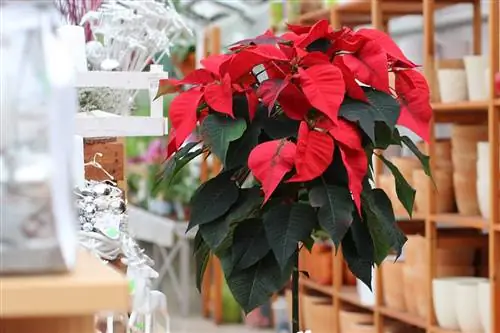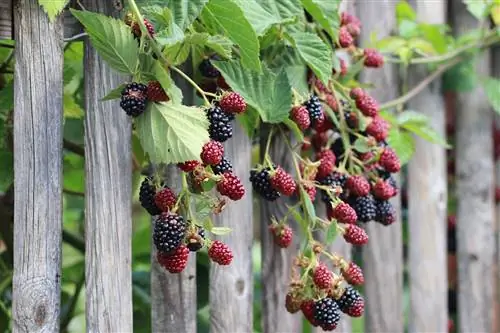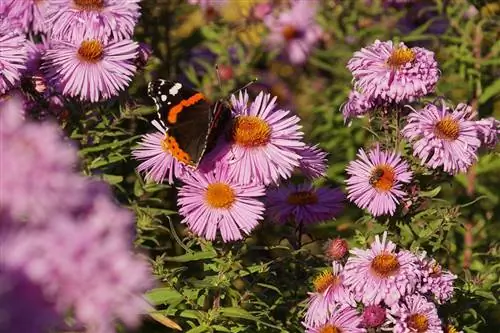- Author admin [email protected].
- Public 2023-12-17 03:39.
- Last modified 2025-06-01 06:48.
Caring for poinsettias is a real headache for many customers and hobby gardeners. During the Christmas holidays it is in all its glory with its bright red leaves. It doesn't take long until the first dark green leaves fall off the plant and it is soon bare. Then unfortunately one of the beautiful plants ends up in the trash can. You can find out how to care for and maintain your Euphorbia in our instructions.
Care
The poinsettia originally comes from the tropical forests of Central and South America. Here it found its way from Mexico via Brazil and Venezuela to the Caribbean islands, where it can still be found in nature today. In these regions it grows as a wild plant and can reach a height of up to four meters. Today its habitat extends from the Mediterranean to Africa and Asia. During your holiday in Tenerife you are very likely to come across poinsettias growing in nature.
Poinsettia flowers are not actually flowers, but leaves that turn red when they have less than twelve hours of light per day. So if you keep your poinsettia in the new year, the entire plant will continue to grow lush green leaves. As soon as the days get shorter again in our local latitudes, the typical red color develops again.
Light soil or a high-quality substrate
The perennial crop is cut back and repotted in spring between March and April. Fine soil or a light substrate is used for this. The poinsettia doesn’t like heavy soil. The risk that the soil will retain moisture for too long and the roots will rot is always present with heavy soil.
Finding a good location
Nevertheless, it feels very comfortable in a bright location and will pamper you with its strong to bushy growth. However, in the summer months, direct sunlight is unfavorable and should be avoided. The bedroom or living room, which provides sufficient light with a translucent curtain but does not let the sun's rays into the room, is a suitable location. In the winter months, however, the sun's power is not as strong and does not harm the plant. Especially in winter, you should remember that less than twelve hours of light are necessary for the red leaves to form, and you must adjust the location for the poinsettia accordingly.
If you want to make sure that your plant blooms before the first Advent, you can easily force this by putting an opaque bucket over the plant and thus drastically reducing the light conditions every day.
The poinsettia cannot tolerate drafts. In this respect, its place should not be near windows that are opened daily for ventilation. The draft from the front door of the house should also be taken into account.
Irrigation
The poinsettia originally comes from the south and has adapted to the climatic conditions. It requires little water and should definitely not be watered daily. The soil or substrate should only have residual moisture. If it has too much water, it will quickly drop its leaves or, in the worst case, die. For watering, you can also use the immersion method, in which the pot is immersed in lukewarm water. As soon as no air bubbles appear, the pot is placed in a place where the excess water can drain away. Depending on the room conditions, this process is only repeated about once a week. However, as long as the peat on the surface is dark and not dried out, the poinsettia still has enough liquid.
The right fertilization
Add fertilizer to the irrigation water regularly during the flowering period or use fertilizer sticks. The plant can also be fertilized once or twice at most during the growth phase. If you notice that your plant is growing too quickly, stop fertilizing for a few weeks, otherwise it will shoot up too quickly.
You should avoid fertilizing shortly after flowering. The plant needs a period of regeneration. Make sure that you use a fertilizer rich in potash that provides the poinsettia with the necessary substances.
Approx. Five weeks before the planned flowering in winter, it also receives a flowering fertilizer with a high phosphorus content, which is added to the irrigation water every 14 days. The manufacturer's instructions must be strictly adhered to. It is better to reduce the specified amount a little.
Reproduction - not easy but still possible
The poinsettia is not particularly easy to propagate using cuttings. Try your luck. As a rule, propagation requires an experienced hand. You will be all the happier if you have managed to grow a new poinsettia.
For care in March-April
the plants are cut back and repotted. You can even put the poinsettia outside in the summer, where it feels particularly comfortable. If you want to see the first bracts on time for the 1st Advent, you have to give the plant an artificial night's rest from October onwards. They need 12 hours of darkness for the bracts to color. All you need to do is cover them with a cardboard box or a dark bucket and thus extend the night's sleep to 12 hours. If you want the poinsettia to bloom in summer too, you just need to use this technique. The plant only needs a little water. The soil always needs to be only slightly moist. Most people make the mistake of simply watering the plant too much. However, this will do more harm than good.
Location: Poinsettia likes it bright and sunny, but it also thrives beautifully in partial shade. You should just make sure that the location is not too warm. The most ideal temperatures during flowering are between 15 and 22°C. If it is too warm or too dark, the plant simply grows long, develops yellow leaves and eventually dies. The plant is only fertilized during its flowering period. Provide sufficient nutrition once a week with any complete fertilizer.
Propagation can be done using cuttings, but it's not worth the effort as the plants can be had for little money during Advent.
Making the poinsettia bloom again
The poinsettia is one of the short-day plants that need short days and long nights to bloom again. It only blooms if it is dark for at least twelve hours a day for several weeks. Artificial light also prevents flowering, so a potted plant for which there is no room in the house that is dark enough for long can be covered with a cardboard box, a bucket or any other material that does not allow light to pass through. In order for a poinsettia to start blooming again in time for Advent, it should be kept dark from the beginning of October. At the same time, fertilization is stopped at this time.
Diseases of Euphorbia Pulcherrima
A poinsettia that doesn't bloom is probably due to a lack of darkening. Fallen leaves, on the other hand, can be an indication of too much or too little water, but a poinsettia cannot tolerate drafts either. Particular caution is therefore required when purchasing such a plant. For the way home it should be wrapped in several layers of paper so that it doesn't get damaged on the way. The flowers with the red bracts last particularly long if the poinsettia is bright but not too warm. A place directly above the radiator is therefore not particularly suitable. Pests such as aphids, spider mites or whiteflies may occasionally appear. This is usually due to care errors, so these insects will usually disappear on their own if the site conditions are improved.






